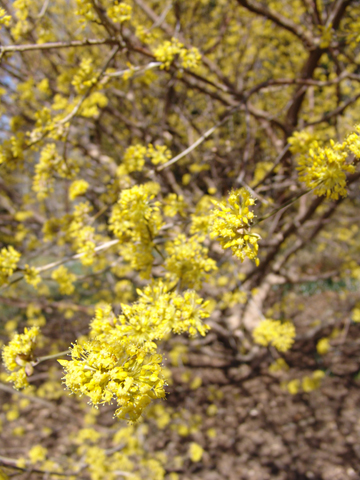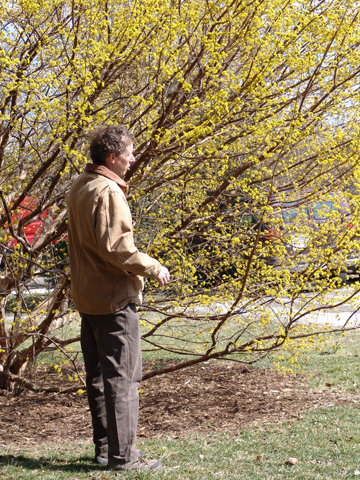Cornus mas
March’s pick for Plant of the Month is one of my favorite early blooming trees, Cornus mas, or the Cornelian cherry dogwood. Becky Robert, our Member and Visitor Programs Coordinator, wrote an informative article on Cornus mas for our blog last week, so I won’t reinvent the wheel here. Instead, I’d like to share a few added tidbits about this plant that is currently showing its colors at the Scott Arboretum:
- To best highlight the bright color of Cornus mas flower clusters, I recommend selecting a planting site near a dark-colored background, such as a building or dense conifer. This way, its bright yellow color will pop!
- As much as I enjoy the flowers of Cornus mas, my favorite aspect of the plant is the deeply red drupe-like berries it produces in the summer. While some people might find them unpalatable, I enjoy eating the berries straight off the tree; they remind me of the sweet-tart flavor of cranberries. An even tastier way to consume Cornelian cherry fruit is to turn it into a jam. Below is a recipe I’ve had success with. The jam tastes great on top of a good, crusty bread…just watch out for the pits and make sure the berries are fully ripe when picked.
4 cups of sugar
2 1/2 cups of water
1 pound of Cornelian cherry fruit
In a large pot, bring the sugar and water to a boil, stirring until the sugar dissolves. Simmer the liquid for 15 minutes. Stir in the fruit and simmer for an additional 30 minutes, or until the syrup has thickened. Periodically skim off the foam that comes to the surface of the mixture. Pour into sterile jars and seal (or consume right away to save that trouble).
- To provide some historical context to our Plant of the Month, here are some interesting facts:
- The genera name, Cornus, is derived from the Latin word for horn, referring to the very hard wood of the dogwood
- This hard wood was valued greatly by the Greeks, and it is said they used Cornelian cherry wood to make javelins and spearheads
- In his 1914 publication, The Standard Cyclopedia of Horticulture, horticultural rockstar Liberty Hyde Bailey explains that dogwood trees get their common name because a medicinal extract from their leaves was used in England to wash mangy dogs.
Whether you choose to eat its berries, make tools from its wood, wash your dogs in its extract, or simply admire its beautiful springtime blooms, Cornus mas is a great garden woody, one that I would recommend to any home gardener. Of course, if you cannot plant it at home, paying us a visit at the Scott Arboretum is the next best thing. We would love to see you here this Spring!







Michelle
Posted at 18:18h, 12 AugustHello –
We have a cornus mas tree in our back yard and our 9 month old puppy likes to eat the berries – is this safe for her to eat? We have done our best to clean up the berries off the ground but she does seem to get the occasional few in her mouth?
Any advice would be great.
Thank you Michelle
Andrew Bunting
Posted at 09:53h, 13 AugustMichelle,
The ripe fruits on Cornus mas are actually edible. Your dog probably at the seed to which should just pass in its stool and your dog should be fine.
Andrew Bunitng, Curator
Julie Elliott
Posted at 14:10h, 07 OctoberCornus Mas or Cornelian Cherry trees are hard to find.
I understand you must have a male and a female tree to bear fruit. How do you identify this in making a purchase?
Andrew Bunting
Posted at 08:52h, 10 OctoberI don’t believe that there are male and female plants of Cornus mas. You should easily be able to find a mail order source.
Andrew Bunting, Curator